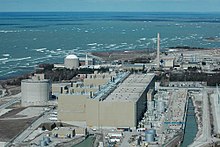See also: List of prospective nuclear units in the United States, Nuclear power in the United States, Nuclear energy policy and Mitigation of global warming
As already noted, the nuclear power industry in western nations has a history of construction delays, cost overruns, plant cancellations, and nuclear safety issues despite significant government subsidies and support.[90][235][236][237] In December 2013, Forbes magazine reported that, in developed countries, “reactors are not a viable source of new power”.[238] Even in developed nations where they make economic sense, they are not feasible because nuclear’s “enormous costs, political and popular opposition, and regulatory uncertainty”.[238] This view echoes the statement of former Exelon CEO John Rowe, who said in 2012 that new nuclear plants “don’t make any sense right now” and won’t be economically viable in the foreseeable future.[238] John Quiggin, economics professor, also says the main problem with the nuclear option is that it is not economically-viable. Quiggin says that we need more efficient energy use and morerenewable energy commercialization.[150] Former NRC member Peter Bradford and Professor Ian Lowe have recently made similar statements.[239][240] However, some “nuclear cheerleaders” and lobbyists in the West continue to champion reactors, often with proposed new but largely untested designs, as a source of new power.[238][239][241][242][243][244][245]
Much more new build activity is occurring in developing countries like South Korea, India and China. China has 25 reactors under construction, with plans to build more,[246][247] However, according to a government research unit, China must not build "too many nuclear power reactors too quickly", in order to avoid a shortfall of fuel, equipment and qualified plant workers.[248]
In the USA, licenses of almost half its reactors have been extended to 60 years,[249][250] Two new Generation III reactors are under construction at Vogtle, a dual construction project which marks the end of a 34 year period of stagnation in the US construction of civil nuclear power reactors. The station operator licenses of almost half the present 104 power reactors in the US, as of 2008, have been given extensions to 60 years.[249] As of 2012, U.S. nuclear industry officials expect five new reactors to enter service by 2020, all at existing plants.[31] In 2013, four aging, uncompetitive, reactors were permanently closed.[32][33] Relevant state legislatures are trying to close Vermont Yankee and Indian Point Nuclear Power Plant.[33]
The U.S. NRC and the U.S. Department of Energy have initiated research into Light water reactor sustainability which is hoped will lead to allowing extensions of reactor licenses beyond 60 years, provided that safety can be maintained, as the loss in non-CO2-emitting generation capacity by retiring reactors "may serve to challenge U.S. energy security, potentially resulting in increased greenhouse gas emissions, and contributing to an imbalance between electric supply and demand."[251]
There is a possible impediment to production of nuclear power plants as only a few companies worldwide have the capacity to forge single-piece reactor pressure vessels,[252]which are necessary in the most common reactor designs. Utilities across the world are submitting orders years in advance of any actual need for these vessels. Other manufacturers are examining various options, including making the component themselves, or finding ways to make a similar item using alternate methods.[253]
According to the World Nuclear Association, globally during the 1980s one new nuclear reactor started up every 17 days on average, and by the year 2015 this rate could increase to one every 5 days.[254] As of 2007, Watts Bar 1 in Tennessee, which came on-line on February 7, 1996, was the last U.S. commercial nuclear reactor to go on-line. This is often quoted as evidence of a successful worldwide campaign for nuclear power phase-out.[255] Electricity shortages, fossil fuel price increases, global warming, and heavy metal emissions from fossil fuel use, new technology such as passively safe plants, and national energy security may renew the demand for nuclear power plants.

